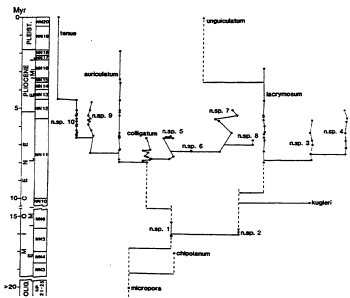rates would fare just as well as groups with equally lower rates. But
extinction intensities vary greatly, and the geological record features
episodes of high dying. during which extinction-prone groups are more
likely to disappear, leaving extinction-resistant groups as life's legacy.
Valentine concludes that "these clade-characteristic rates are of
course not adaptations per se, but effects flowing from clade properties
that were established probably during the early radiations that founded
the clades."
The most exciting direct extensions of punctuated equilibrium now involve
the study of correlated punctuational events across taxa, and the ecological
and environmental sources of such cohesion. Eminently testable are Vrba's49
"turnover-pulse hypothesis" of evolution concentrated in punctuational
bursts at times of worldwide climatic pulsing, one of which, about 2.5
million years ago. may have stimulated the origin of the genus Homo;
and Brett's50 hypothesis of "coordinated stasis"
for the structuring of major palaeontological faunas. What might be the
ecological source of such striking coherence across disparate taxa through
such long times?51
The empirics of punctuated equilibrium
Like all major theories in the sciences of natural history, including
natural selection itself, punctuated equilibrium is a claim about relative
frequency, not exclusivity52. Phyletic gradualism has been
well documented, again across all taxa from microfossils53
to maramals54,55. Punctuated equilibrium surely exists in abundance,
but validation of the general hypothesis requires a relative frequency
sufficiently high to impart the predominant motif and signal to life's
history. The issue remains unsettled, but we consider (in our biased way)
that four classes or evidence establish a strong putative case for punctuated
equilibrium in this general sense.
|
Individual cases. Examples of stasis
alone (cited earlier) and simple abrupt |
replacement, although conforming to expectations of punctuated equilibrium,
are not direct evidence for our mechanism: for stasis might just be a lull
in anagenetic gradualism (though pervasive stasis for long periods in all
species of a fauna (a common finding) would require special pleading from
gradualists), and replacement might represent rapid transformation without
branching, or migration of a distant (phyletic or geographic) relative rather
than evolution in situ. A good test of punctuated equilibrium requires
(in addition to the obvious need for documented rapidity in an interval
known to be sufficiently short) both a phyletic hypothesis to assert sister-group
relationship of the taxa involved, and survival of putative ancestors to
affirm an event of true branching rather than rapid phyletic transformation.
Given these stringent requirements, and in the light of such an imperfect
fossil record, we are delighted that so many cases have been well documented,
particularly in the crucial requirement of ancestral survival after punctuated
branching32.56-61. Williamson's discovery62 of multiple
molluscan speciation events in isolated African lakes, with return of
ancestral lineages upon reconnection with parental water bodies, has been
most widely discussed63 and disputed64 (although
all accept the punctuational pattern). Cheetham's elegant and meticulously
documented65.66 story of evolution in the bryozoan Metrarabdotos
from Tertiary strata of the Caribbean is particularly gratifying (Fig.
2) in the number of purely punctuational events, the full coverage of
the lineage, and the unusual completeness of documentation, especially
as Cheetham began his study expecting to reconfirm a gradualistic interpretation
(writing to McKinney: "The chronoclinc I thought was represented
. . . is perhaps the most conspicuous casualty or the restudy, which shows
that the supposed cline members largely overlap each other in time. Eldredge
and Gould were certainly right about the danger of stringing a series
of chronologically isolated populations together with a gradualist's expectations.")
On the subject of punctuational corrections for received gradualistic
wisdom. Prothero and Shubin 67 have shown that the most 'firmly' gradualistic
part of the horse lineage (the general, and false, exemplar of gradualism
in its totality), the Oligocene
| FIG. 2 Reproduced with permission from ref. 65. Phylogenetic (stratophenetic)
tree of Caribbean species of Metrarabdotos. Relationships were constructed
by calculating euclidean distances between sampled populations using all
canonical scores from discriminant analysis, and connecting nearest morphological
neighbours in stratigraphic sequence. Morphological distances (horizontal
axis) between inferred ancestor and descendant species are to scale; those
between species of different pairs are not necessarily so (for example,
M. kugleri is morphologically more distant from M. n. sp. 3 than from
its ancestor, M. n. sp. 2, even though the diagram makes it appear otherwise).
Within-species fluctuation in species-distinguishing morphology is based
on pairwise discriminant scores scaled to the distances between species
pairs. |
 |
| NATURE - VOL 366 - 18 NOVEMBER 1993 |
225
|
|
